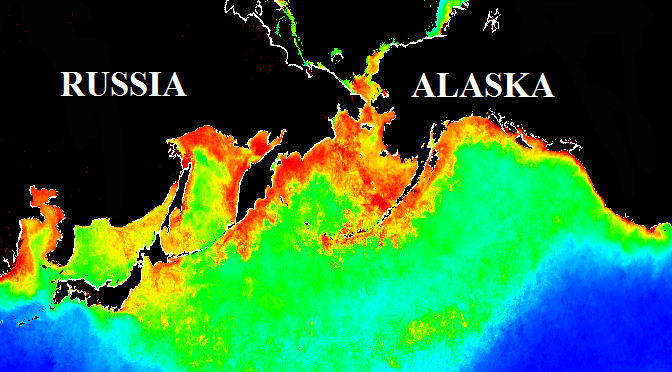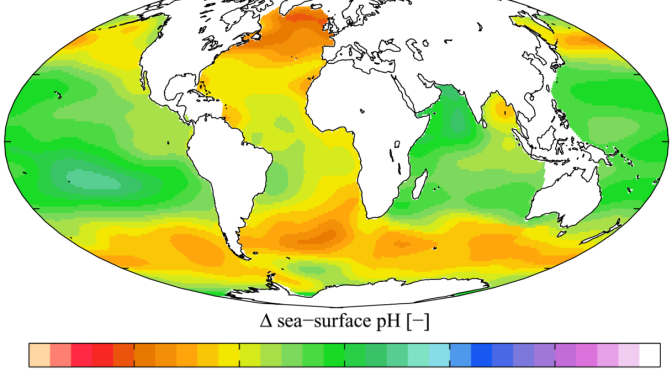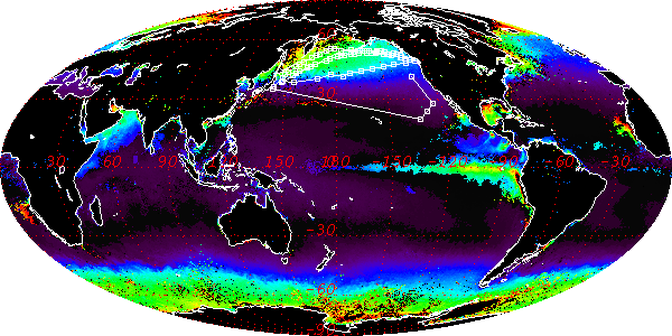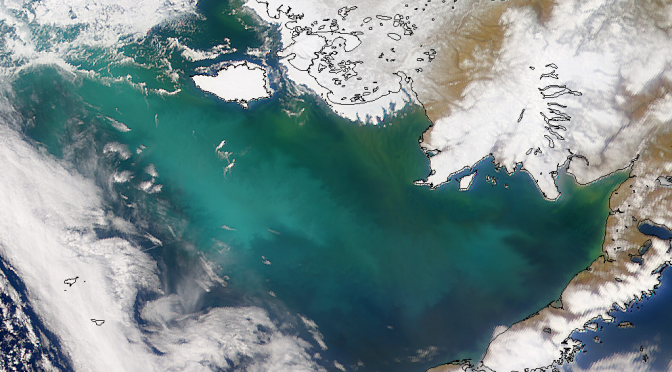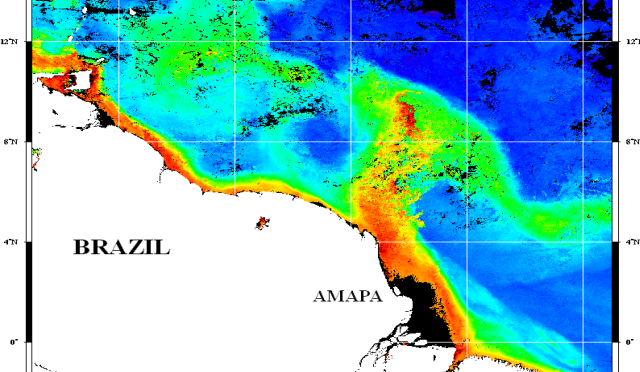Category Archives: Research
SUBARCTIC PACIFIC OCEAN
Using an unique method developed by us that estimates nitrate and new production from space we investigated how large-scale climatic events over the North Pacific contribute to inter-annual variability in biological productivity and new production in different regions of the subarctic Pacific Ocean. Our findings show a remarkable east-west gradient in biological productivity driven by external forcing such as wind, winter convective mixing and El Niño events which in turn affect nitrate concentrations, Fe deposition, available light and temperature all of which control phytoplankton productivity and CO2 uptake. For more information go to: THE INFLUENCE OF LARGE SCALE ENVIRONMENTAL CHANGES ON CARBON EXPORT IN THE NORTH PACIFIC OCEAN: A COMPREHENSIVE STUDY USING SHIPBOARD AND REMOTE SENSING DATA
Published work includes
Increased CO2 and Ocean Acidification
 CARBON DIOXIDE MANIPULATION EXPERIMENTS IN THE LABORATORY
CARBON DIOXIDE MANIPULATION EXPERIMENTS IN THE LABORATORY
Thalassiosira weissflogii (a diatom species) was grown under three different CO2 environments: 150 ppm (pre-industrial concentrations), 400 ppm (present day), and 800 ppm (end of the century prediction).
- Phytoplankton biomass and growth rates were monitored over time by taking samples for in vivo chlorophyll a measurements and cell counts using FlowCAM®
- Changes in absorption spectra of pigments were examined using a spectrophotometer
- Changes in the photosynthetic capacity of the cells were examined using a Fast Repetition Rate Fluorometer (FRRF)
BASIN SCALE NITRATE CONCENTRATIONS FROM SPACE
A TIME SERIES OF SEA SURFACE NITRATE AND NITRATE BASED NEW PRODUCTION IN THE GLOBAL OCEANS
We are part of NASA’s MEaSUREs program (Making Earth System Data Records for Use in Research Environments) that strives to provide data products and services for the advancement of Earth remote sensing and pioneers to improve human understanding of our home planet in order to inform economic and policy decisions and improve operational services of benefit to the Nation.
Through the MEaSUREs Program, NASA is continuing its commitment to expand understanding the Earth system using consistent records.
We have been selected to produce an Earth System Data Records (ESDR) which is defined as a unified and coherent set of observations of a given parameter of the Earth system, optimized to meet specific requirements in addressing science questions. These records are critical to understanding Earth System processes, to assessing variability, long-term trends, and change in the Earth System, and to provide input and validation means to modeling efforts.
We are proposing to create two new and innovative ESDRs: Sea Surface Nitrate (SSN) and Nitrate based new production (NnP) using NASA’s high quality remotely sensed phytoplankton Chlorophyll a (Chl) and Sea Surface Temperature (SST). Oceanic primary productionis regulated primarily by the supply of inorganic nitrogen, primarily nitrate (N), while new production constitutes the major fraction of carbon fixed through photosynthesis transported into the oceans’ interior.
BERING SEA -THE GATEWAY TO THE ARCTIC
INFLUENCE OF THE BERING SEA ON ARCTIC ECOSYSTEMS EXPERIENCING RAPID REDUCTIONS IN SEA-ICE

The presence of a strong halocline in the Arctic Ocean represents a major impediment for vertical transport of nutrients from the deep Arctic Ocean into the upper euphotic zone. As a consequence, primary production rates in these waters are largely dependent on nutrients advected from elsewhere.

Two of the most productive ecosystems of the Arctic Ocean, the Chukchi and Beaufort Seas are largely dependent on nutrients supplied by Pacific waters flowing northwards through the Bering Strait. Our ongoing shipboard, satellite, mooring and modeling studies, have allowed us to observe large intra-seasonal to annual changes in the rate of formation and retreat of sea-ice in the Bering Sea that have a significant impact on phytoplankton standing stocks and the composition of native phytoplankton and zooplankton communities. Here we contend that changes in phytoplankton production and nutrient drawdown rates associated with variations in sea-ice conditions in the Bering Sea could significantly influence the transport of nutrients, particulate and colored dissolved organic materials into the Arctic Ocean through the Bering Strait and consequently, the patterns of productivity and structure of plankton communities of the Chukchi Sea and the western Pacific Arctic Ocean. In recent years, the Bering Sea has been experiencing a cold spell and extensive sea-ice conditions which are in sharp contrast to the warming trend and rapid seasonal losses of sea-ice observed in the Arctic Ocean. These regional variations in sea-ice behavior make the physical and biogeochemical connections and interactions between these two regions intriguing for research.
Arabian Sea
AMAZON CONTINUUM
Alluvial discharge from the Amazon River is the largest of all the world’s rivers bringing with it nutrients, suspended solids, and dissolved organic matter to the Western Tropical North Atlantic (WTNA) Ocean. As the fresh river water meets the sea, a 5-20 m thick plume develops that reaches more than 3000 km across the ocean and covers nearly 2 million km2. The gradient of environmental conditions that evolve as the plume meanders northwards and mixes with the waters of the WTNA Ocean strongly impacts phytoplankton communities of the Amazon River plume continuum. At the mouth of the river, phytoplankton are light limited because of the high concentrations of riverine suspended particles and CDOM which strongly absorbs short wavelength light. Further offshore, large blooms of diatom-diazotroph associations (DDAs) dominated providing significant inputs on nitrogen as well being responsible for a significant CO2 drawdown.Our findings show the following:

Diatoms are physiologically flexible and have efficient carbon concentrating mechanisms to grow in a wide range of pCO2.
Diatom-Diazotroph Associations (DDAs) seem to dominate waters with a narrow range of pCO2 values of 350-400 ppm.
The Diazotroph Trichodesmium spp. grows in a wide range of pCO2 conditions, but higher counts were found at higher pCO2, upwards of 500 ppm.


